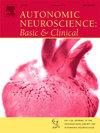自组织临界,龙王,黑天鹅,和血管迷走神经性晕厥的预测
IF 3.3
4区 医学
Q2 NEUROSCIENCES
引用次数: 0
摘要
血管迷走神经事件发生的范围很广,从轻微事件到导致晕厥的严重事件。这些事件的强度分布遵循幂定律,正如自组织临界(SOC)的普遍理论所描述的那样。极端SOC事件可能表现为不可预测的“黑天鹅”或可预测的异常值,称为“龙王”。本研究旨在描述导致(近)晕厥的最重要事件的性质。我们分析了11名在平视倾斜试验中经历血管迷走神经性(近)晕厥的健康个体的rr间隔时间序列。根据心动过缓序列的强度(心跳次数)进行评估,构建Zipf分布,计算回归系数r。根据最新的识别事件类型的三步方法,我们首先比较了有和没有血管迷走神经(VV)事件的Zipf分布。接下来,我们应用时间重新缩放,最后,我们完善心动过缓序列的定义。第一步未能证明血管迷走神经性晕厥为龙王(无VV的r和有VV的r分别为0.98±0.00和0.98±0.00)。第二步被证明是不确定的,因为时间缩放破坏了幂律分布。然而,第三步显示,最大事件作为异常值或可预测的龙王,显著改变了事件分布的相关系数(无异常值和有异常值的r分别为0.98±0.01和0.86±0.02,p = 0.001)。我们的研究结果表明,血管迷走神经性晕厥代表了一个处于临界状态的自组织系统中的龙王。这些结果为基于SOC理论的最新进展预测血管迷走神经性晕厥铺平了道路。本文章由计算机程序翻译,如有差异,请以英文原文为准。
Self-organized criticality, dragon kings, black swans, and the prediction of vasovagal syncope
Vasovagal events occur across a spectrum, from minor events to severe episodes resulting in syncope. The intensity distribution of these events follows a power law, as described by the universal theory of self-organized criticality (SOC). Extreme SOC events may manifest as unpredictable “black swans” or predictable outliers called “dragon kings.” This study aimed to characterize the nature of the most significant events leading to (near)syncope.
We analyzed RR-interval time series from eleven healthy individuals who experienced vasovagal (near)syncope during a head-up tilt test. Bradycardia sequences were evaluated based on their intensity (number of beats) to construct Zipf's distributions and calculate the regression coefficient (r). Following the latest three-step approach for identifying event types, we first compared Zipf's distributions with and without the vasovagal (VV) event. Next, we applied time rescaling, and finally, we refined the definition of bradycardia sequences.
The first step failed to demonstrate vasovagal syncope as a dragon king (r without VV vs. r with VV: 0.98 ± 0.00 and 0.98 ± 0.00, respectively). The second step proved inconclusive, as time rescaling disrupted the power law distribution. However, the third step revealed that the largest events acted as outliers or predictable dragon kings, significantly altering the correlation coefficient of event distribution (r without vs. with outliers: 0.98 ± 0.01 and 0.86 ± 0.02, respectively, p = 0.001).
Our findings suggest that vasovagal syncope represents a dragon king in a self-organized system poised at criticality. These results pave the way for predicting vasovagal syncope based on recent advancements in SOC theory.
求助全文
通过发布文献求助,成功后即可免费获取论文全文。
去求助
来源期刊
CiteScore
5.80
自引率
7.40%
发文量
83
审稿时长
66 days
期刊介绍:
This is an international journal with broad coverage of all aspects of the autonomic nervous system in man and animals. The main areas of interest include the innervation of blood vessels and viscera, autonomic ganglia, efferent and afferent autonomic pathways, and autonomic nuclei and pathways in the central nervous system.
The Editors will consider papers that deal with any aspect of the autonomic nervous system, including structure, physiology, pharmacology, biochemistry, development, evolution, ageing, behavioural aspects, integrative role and influence on emotional and physical states of the body. Interdisciplinary studies will be encouraged. Studies dealing with human pathology will be also welcome.

 求助内容:
求助内容: 应助结果提醒方式:
应助结果提醒方式:


